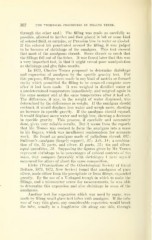Page 624 - My FlipBook
P. 624
302 THE TECHNICAL, PROCEDUKES IN FILLING TEETH.
through the other end.) The filling was made as carefully as
possible, allowed to harden and then placed in ink or some kind
of colored fluid, as carmine, or Prussian blue in water or alcohol.
If the colored ink penetrated around the filling, it was judged
to be because of shrinkage of the amalgam. This test showed
that most of the amalgams shrank. Some shrank so much that
the fillings fell out of the tubes. It was found later that this was
a very imperfect test, in that it might reveal poor manipulation
as shrinkage and give false results.
In 1871, Charles Tomes proposed to determine shrinkage
and expansion of amalgam by the specific gravity test. For
this purpose, fillings were made in any kind of matrix or formed
cavity which permitted the filling to be removed complete soon
after it had been made. It was weighed in distilled water at
a predetermined temperature immediately, and weighed again in
the same manner and at the same temperature after it had set.
The difference, if any, in the weight of water displaced, was
determined by the differences in weight. If the amalgam should
contract, it would displace less water and weigh more, showing
an increase in specific gravity. If the amalgam should expand,
it would displace more water and weigh less, showing a decrease
in specific gravity. This process, if carefully and accurately
done, gives very reliable results. But it seems from the reports
that Mr. Tomes was content to form the amalgam into a mass
in his fingers, which was insufficient condensation for accurate
work. He found an amalgam made of palladium shrunk .037;
Sullivan's amalgam (largely copper), .07; Ash, .14; a combina-
tion of tin, 55 parts, and silver, 45 parts, .35; tin and silver,
equal quantities, .38. Supposing the figures given by Mr. Tomes
represent shrinkage to be percentages of cubical contents of the
mass, they compare favorably with shrinkages I have myself
measured for alloys of about the same composition.
Kirby (Transactions of the Odontological Society of Great
Britain, 1871, 1872, New Series) found that amalgams of pure
silver, made either from the precipitate or from filings, expanded
greatly. By the use of a V-shaped trough in which to make the
fillings, and a micrometer screw for measurements, he was able
to determine this expansion and also shrinkage in some of the
amalgams.
Another test for expansion which was used by many, was
made by filling small glass test tubes with amalgam. If the tube
was of very thin glass, any considerable expansion would break
the tube, usually in a lengthwise slit along one side, through


